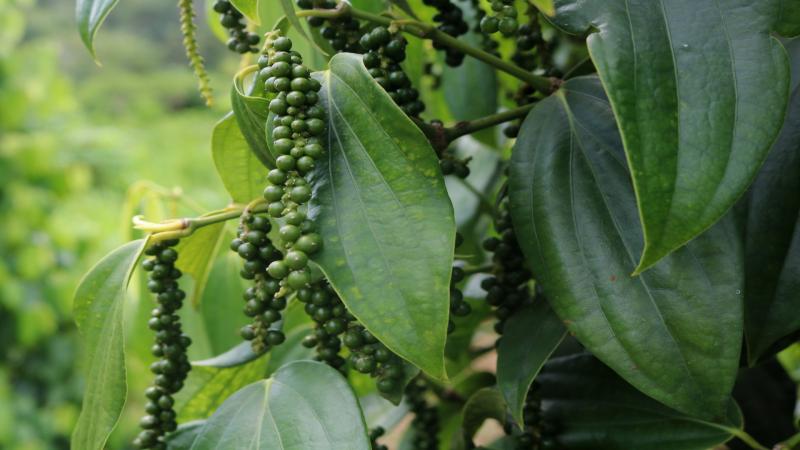
Indian pepper, also dubbed as “black gold”, holds great economic importance and is a hot topic for scientists in understanding its biogeographical origins. The historical connections between India and Gondwanaland has led to interesting debates about the biodiversity and floral connections between the two regions, particularly the spread of the genus Piper following the Gondwanaland break up around 66–100.5 million years ago.
The pepper family, Piperaceae, contains more than 1500 species globally, with most of them concentrated in the tropical regions of the Americas. Around 600 species exist in South Asia and their evolutionary relationship—their phylogeny—to the Indian Piper species requires greater explorations.
In a recent study published in the journal Molecular Phylogenetics and Evolution, a team of researchers from the Ashoka Trust for Research in Ecology and the Environment (ATREE), Bengaluru, Concordia University, Canada, Quebec Centre for Biodiversity Science, Canada, and Jawaharlal Nehru Tropical Botanical Garden and Research Institute, Kerala, have traced the biogeographical origins of genus Piper in India. The study was funded by the International Association for Plant Taxonomy, Department of Biotechnology and Department of Science and Technology-Science and Engineering Research Board.
“Piper is one of the largest angiosperm groups with a very complex taxonomy. I think it is important to settle the taxonomy since it has several economically and medicinally important species which is a prerequisite for developing conservation measures,” says Mr Sandeep Sen, a researcher at ATREE and an author of the paper.
The researchers tested whether the Peninsular Indian Piper is of Gondwanan or Malayan origin, which has not been explored before. Several hypotheses explain the journey of the genus from Gondwana to Eurasia through the Indian subcontinent. For the first time, by reconstructing the evolutionary tree of 21 species of Piper, the team has traced the arrival of Piper into peninsular India and the mechanisms of diversification of the species into Africa from South Asia. The mechanisms that helped in the diversification of the genus include dispersal (splitting and spreading over a large area), vicariance (geographical separation due to physical barriers), and in-situ radiation (species diversification within the same place).
The team collected leaf samples of Piper species from the Western Ghats, the Eastern Ghats, Northeast India and the Andaman and Nicobar Islands. This included three species assumed to be new from the Western Ghats, out of which the researchers suspect two species to be endemic to Kerala and one to Nilgiris.
The genomic analyses of samples revealed three major branches consisting of species that are direct descendants of a Gondwanan ancestor. They correspond to the species distributed in the Asian tropics (the Himalayas, China, Malaysia, Indonesia, Philippines along with the Andaman and Nicobar Islands), South Pacific (Pacific Islands and New Zealand) and Neotropical region (North, Central and South America), all of which were a part of the Gondwanaland supercontinent. The researchers dated the origin of the Piper to the Cretaceous period around 79 million years ago after which the genus established itself in India during Eocene (56-33.9 million years ago), independent of those species from Southeast Asia.
The phylogenetic analyses also provided evidence for migrations of Piper between Eurasia and Africa via the Arabian Peninsula. The collision between the Indian and Eurasian land masses away from Gondwana around 55-42 million years ago might have paved the way for exchange in plants and animals between the two masses.
The study found that the dispersal of two African pepper species P. borbonense and P. guinense from Southeast Asia into Africa occurred during the Miocene period between 20 to 14 million years when Africa was connected to Eurasia via the Arabian peninsula. In addition, Piper arrived into India from South Asia following the collision and underwent diversifications within India and then dispersing back to South East Asia.
Further, the team also found that Piper nigrum, a widely cultivated pepper species, originated in the Western Ghats during the Late Miocene period 6.3 million years ago. This finding is important as it resolves several speculations surrounding the origin of the species which is of high economic value.
In future studies, the researchers hope, that with a larger sample size containing more species from Northeast India and Southeast Asia, they can better understand the evolutionary processes driving the diversity behind this genus.
“We have received a grant from Christopher Davidson last year to study more about the Piper species in the Himalayas. This will bolster our understanding of the biogeography of Piper in India,” signs off Mr Sen.





